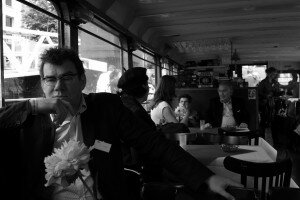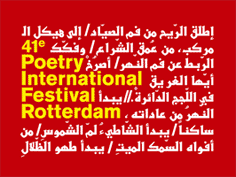Jan Baeke interviewed about the Digital Poetry Lab
Tell me a little about the Digital Poetry Lab.
The Digital Poetry Lab is a joint interdisciplinary project initiated by the Dutch Foundation for Literature and The Netherlands Foundation for Visual Arts, Design and Architecture. The underlying idea is to bring the two disciplines, the visual arts and poetry, together. Through the use of new media, poetry and design are combined in such a way that it adds more value to the visual arts as well as to the poetry. The artists were given the freedom to experiment with sound, language and video and further explore in what ways these can enhance their work. It was a challenge, since at least two of the ten poet-artist duos that participated in the project made a computer application based on a poem. In other words, the poem wasn’t written with the application in mind. It was only after the poem was written that it was changed for computer application.
This year, there is an interactive digital poetry project called ‘Poetry Feeder’ by Leonieke Rammelt and Cheryl Gallaway. Through the website www.poetryfeeder.com, those active on Twitter can send a direct message to the website. This message, in the form of words, phrases, and entire poems, will directly form part of a later text posted by other visitors resulting in a extended collective poem.
The digital poems can also be viewed on www.digidicht.nl which is a Dutch platform for digital poems. The Digital Poetry Lab is in the small auditorium of the Rotterdam City Theatre.
What are the differences between reading a poem on a page, seeing a poet performing their poem at the festival, and digital poetry?
If you make good use of new media, the poem actually needs the screen and requires the digital techniques to achieve a full effect. Through the use of new media, you can attain an enhanced poetic experience. If you display poetry on a screen the way digital poetry does, time plays a vital role. When a poet recites a poem or when you read poetry from the page, of course you’re also dealing with time as a listener/reader. But what it boils down to is that the poem when it’s read aloud (or read from the page) develops within a certain period of time, a fixed time frame. The poet, by reciting his/her poetry, orders the time for the audience/reader, so you have to listen carefully.
With digital poetry, the poem also develops in a particular time span. The main difference between digital poetry and reading poetry from the page is that you have more graphic and sound options and the poem is enriched by sound and visual media. Like a film, digital poetry makes use of images, sound, typography and time as a form of presentation. The poem can also evolve during the presentation. Digital poetry gives you more space to do something special with a poetic text. But this is a complex process. The result of this process, as shown on this year’s Poetry on the Screen project, is that the poem is either a more graphic presentation of a classical poem, or it tends to be something like a video clip.
Do the visual and sound components detract from the poem?
That depends on how you define poetry. Depending on your definition of poetry, digital forms of poetry can add something to a classical / textual poem. I think digital poetry also leads to a new definition of what a poem is. Digital poetry leads to something that cannot be delivered in the same quality in a printed book.
The audio aspect of digital poetry makes it more absorbing than if it were merely visual. It’s a lot easier to move away from image on a screen than it is to ignore sound. Nick Swarth’s images were very strong, for instance, but while listening to the audio, but it was difficult to understand the piece as a poem.

